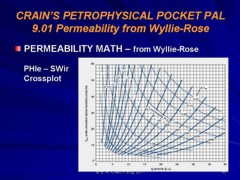|
 Production Profile and Cash Flow
Production Profile and Cash Flow
To calculate
a cash flow estimate for a well or a pool, we need a
production profile from actual well performance or a decline
curve analysis run at equal time increments. It is easiest to generate a monthly flow rate, monthly income,
and monthly expense table, based on the following equations. The
annual decline rate D can be found by
decline curve analysis or from
the simpler production projection /
economic life models elsewhere in this Handbook.
 Cash Flow Analysis
Cash Flow Analysis
Monthly production decline rate:
1: Dp = (1 + D) ^ (1 / 12) - 1
This number must be negative for all real wells.
Monthly price escalation rate.
2: Epr = (1 + EP) ^ (1 / 12) - 1
Monthly expense escalation rate.
3: Eex = (1 + EE) ^ (1 / 12) - 1
Monthly discount rate on money.
4: Dmo = (1 + DM) ^ (1 / 12) - 1
Next, calculate the production and net revenue for the constant
and declining rate portion of the well life. For each month from
the beginning of production to the end of the production, calculate
the following:
5: FOR T = 1 TO Tec
Monthly production at constant rate.
6: IF T <= Tcon
7: THEN Qm = QI * 365 / 12
Monthly production at declining rate.
8: IF T > Tcon
9: THEN Qm = QI * 365 / 12 * ((1 - Dp) ^ (T - Tc))
Monthly gross operating income.
10: GROSSinc = (1 - ORR - ROY) * Qm * Pr * ((1 + Epr) ^ T)
Monthly fixed operating cost.
11: FIXEDcost = COP * ((1 + Eex) ^ T)
Monthly lifting cost.
12: LIFTcost = CLF * Qm * ((1 + Eex) ^ T)
Monthly net operating income.
13: NETinc = GROSSinc - FIXEDcost - LIFTcost
Discounted cash flow.
14: Dcf = NETinc * ((1 + Dmo) ^ T)
Return to working interest.
15: Rwi = WI * DCF
16: END LOOP
To
obtain the total present value of the well, the individual monthly
discounted cash flow must be summed over the life of the well.
Present
value of well.
17: PVtotal = SUM (Dcf) - DCC
Present value of well to working interest.
18: PVwi = WI * PVtotal
Where:
CLF = lifting cost ($/unit prod)
COP = monthly operating cost ($/unit prod)
D = annual production decline rate (fractional)
DCC = drilling and completion cost (dollars)
Dcf = monthly discounted cash flow (dollars)
DM = annual discount rate on money (fractional)
Dmo = monthly discount rate on money (fractional)
Dp = monthly production decline (fractional)
EE = annual expense escalation rate (fractional)
Eex = monthly expense escalation (fractional)
EP = annual price escalation rate (fractional)
Epr = monthly price escalation (fractional)
FIXEDcost = monthly fixed operating cost (dollars)
GROSSinc = monthly gross operating income (dollars)
LIFTcost = monthly lifting costs (dollars/unit prod)
NETinc = monthly net operating income (dollars)
ORR = over riding royalty (fractional)
Pr = product price ($/unit prod)
PVtotal = present value of well (dollars)
PVwi = present value of well to working interest (dollars)
QI = initial daily production rate (units/day)
Qm = monthly production rate (units/month)
ROY = government or freehold royalty (fractional)
Rwi = return to working interest (dollars)
T = time on production (monthly)
Tcon = time at constant production rate (months)
Tec = time at economic limit (months)
WI = working interest (fractional)
 COMMENTS:
COMMENTS:
Payout occurs in the month when Sum (Dcf) = DCC. This can be found
by creating a table of monthly data to see where the payout occurs.
Rate
of return on investment is the discount rate which makes SUM (Dcf)
= DCC at the economic limit of the well. This can be found by
successive iterations with different discount rates until the
equality is met.
 RECOMMENDED
PARAMETERS:
RECOMMENDED
PARAMETERS:
Use local experience.
 NUMERICAL
EXAMPLE:
NUMERICAL
EXAMPLE:
1. For a typical month in the life of the well, assume:
QI = 1000 bopd
Price = $30/bbl
Tc = 32 months
COP = $16000/mo
CLF = $3/bbl
Annual decline rate: D = -0.257
Annual price escalation: EP = +0.06
ORR = 0.10
Annual expense escalation: EE = + 0.08
ROY = 0.20
Annual discount rate: Dm = + 0.25
WI = 0.50
Dp
= (1 + (-0.257)) ^ (1 / 12) - 1 = -0.0245
Dpr = (1 + 0.06) ^ (1 / 12) - = +0.0049
Eex = (1 + 0.08) ^ (1 / 12) = +0.0064
Dmo = (1 + 0.25) ^ (1 / 12) - 1 = + 0.0188
For month number 36 (after constant rate has ended):
Qm = 1000 * 365 / 12 * ((1 + (-0.0245)) ^ (36 - 32)) = 27543 bopm
GROSSinc = (1 - 0.10 - 0.20) * 27543 * 30 * ((1 + 0.0049) ^ (36))
= $689,000
FIXEDcost = 16000 * ((1 + 0.0064) ^ (36)) = $20,.000
LIFTcost = 3 * 27543 * ((1 + 0.0064) ^ (36)) = $104,000
NETinc = 689000 - 20000 - 104000 = $565,000
Dcf = 565000 * ((1 - 0.0188) ^ (36)) = $285,000
Rwi = 0.50 * 285 = $142,000
It
is left to the student to find the present value, payout time,
and rate of return on the example. It is tedious work without a
computer. An example from the author’s META/LOG program is shown
below.
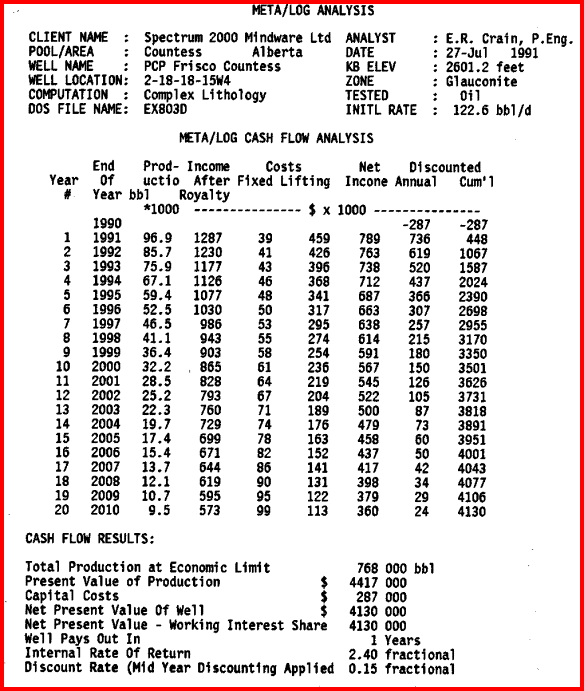
Example from production prediction and cash
flow calculation
 META/LOG "CASH SPREADSHEET -- Cash Flow
META/LOG "CASH SPREADSHEET -- Cash Flow
This
spreadsheet first estimates a production prediction based on
exponential decline, provides for input of costs and prices,
then generates a net cash flow analysis. Note that the defaults
for costs are obsolete.-You can use the cost multiplier to bring
them into line with today's costsm or enter your own data.
Download this speardsheet:
SPR-22 META/LOG PRODUCTION and CASH FLOW CALCULATOR
Calculate production profile,
decline curve, costs, and cash flow of a well from estimated
flow
Units.
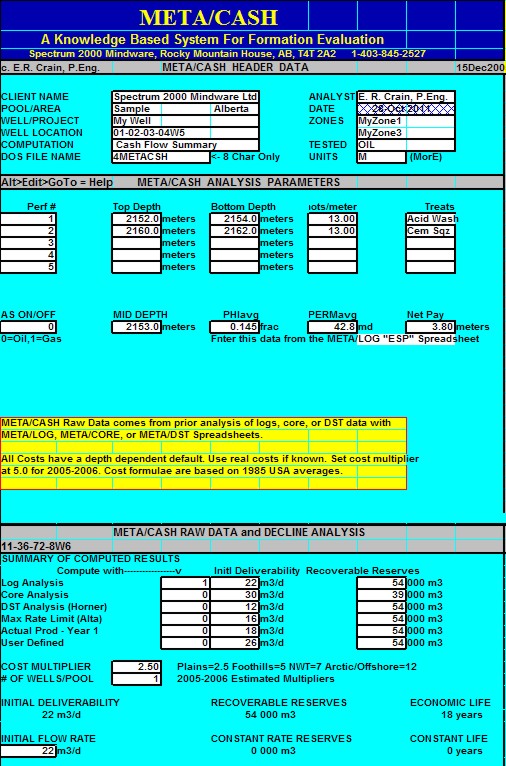
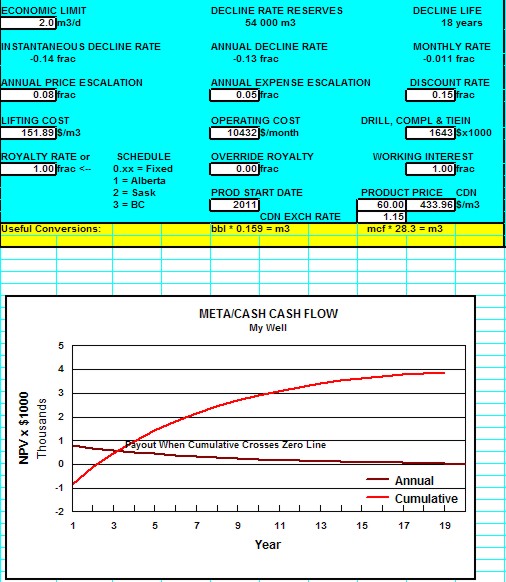
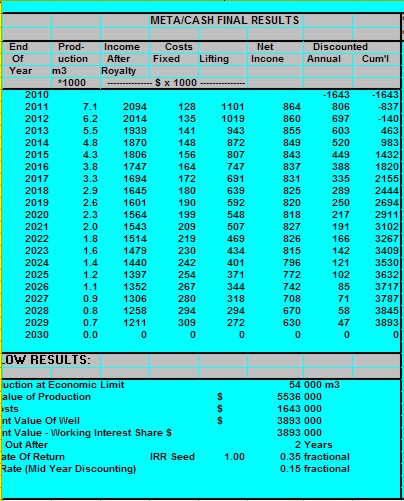
Sample output from "META/CASH" spreadsheet
|


